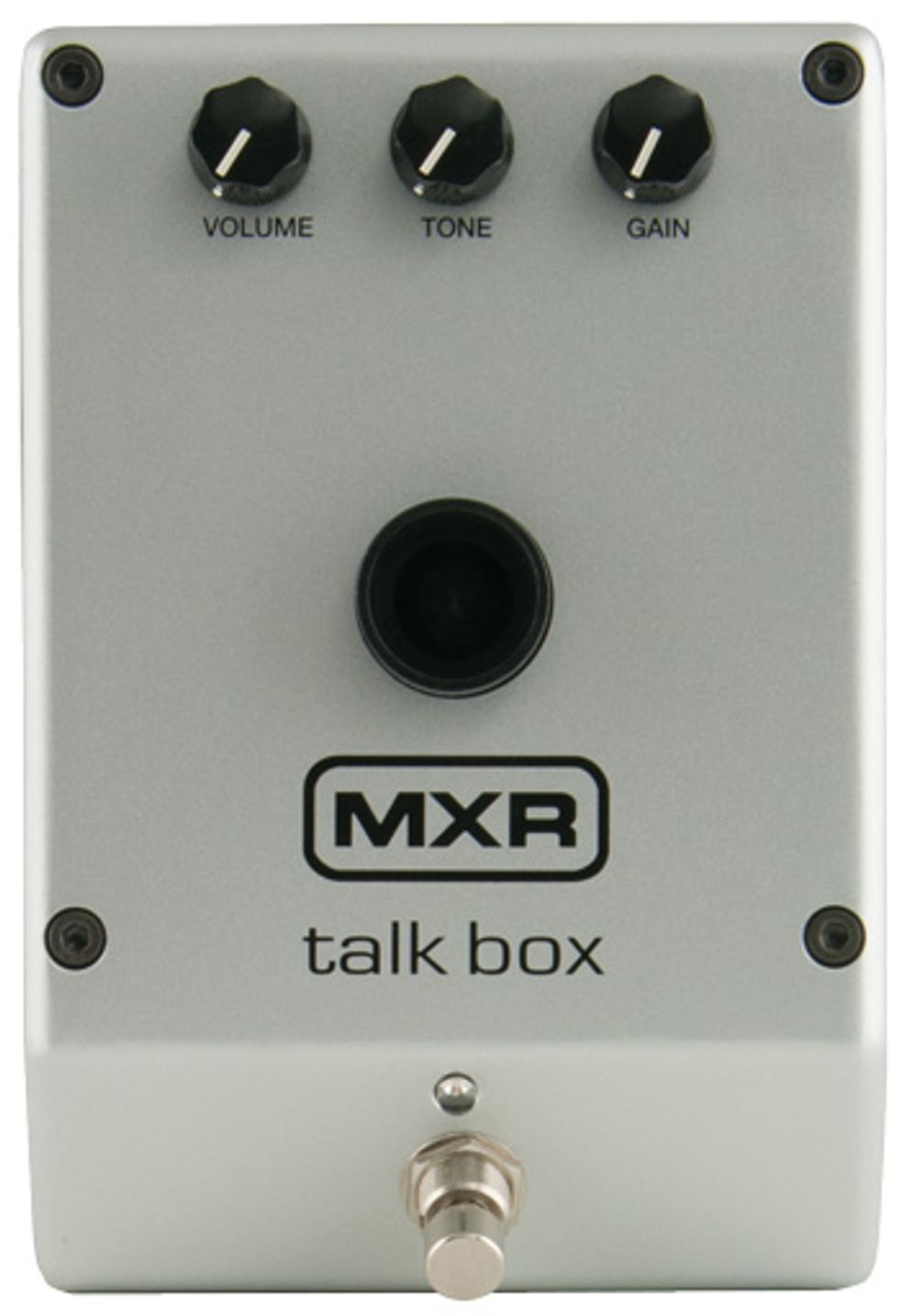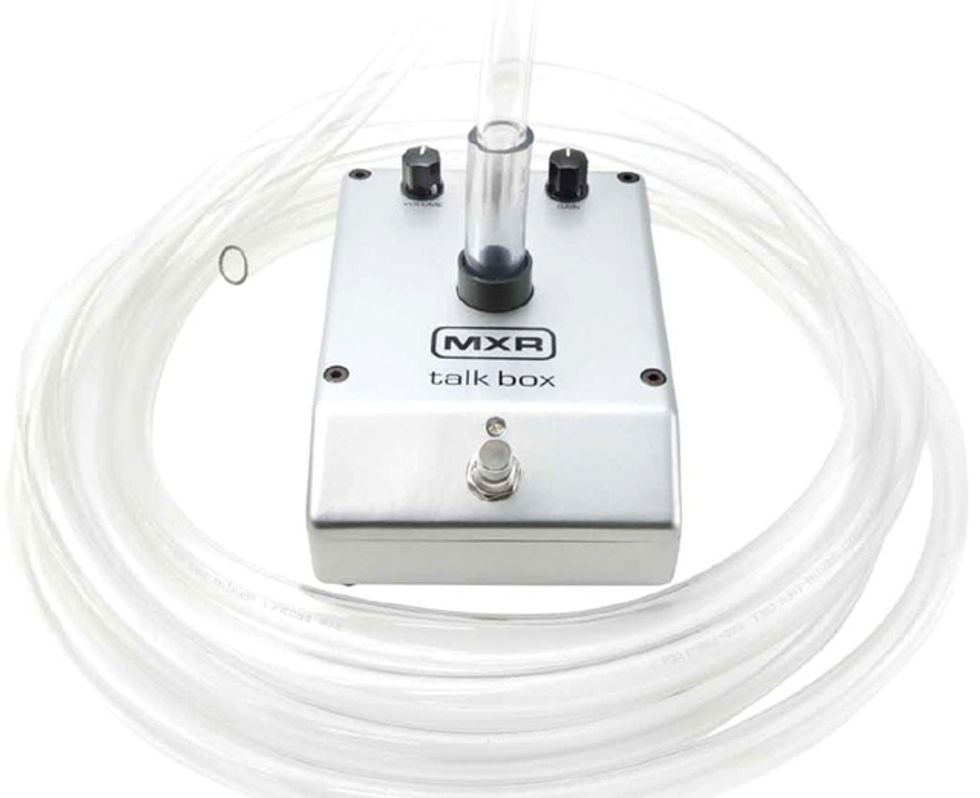The talk box is, without a doubt, one of the most unique and instantly recognizable effects in popular music. With a sound that’s part vocoder and part wah, the effect has been employed by artists from Stevie Wonder to Mick Mars, Richie Sambora, and most notably, Joe Walsh and Peter Frampton. These days, its rare to see or hear a guitarist using one in the wild, but MXR’s new M222 Talk Box aims to change that with a rethink of the formula that emphasizes reliability, circumvents the need for an additional amp, and focuses on affordability.
Tell Me Something Good
The M222 feels incredibly tough. The thick, 2-piece enclosure weighs in at a hefty 2.6 pounds, and it’s held together by five deep-set hex screws. Most of the weight, though, comes from its custom driver and class D amplifier, which eliminates the need to use a separate amp rig to drive the effect. Requiring a completely separate amp has always been one of the most annoying aspects of using a talk box, and MXR has eliminated that obstacle in one brilliant stroke (to be fair, Rocktron’s recent Banshee models also conquered this hurdle). That said, the M222 still requires use of a microphone, and therefore also a PA system or separate mic-friendly amp for amplifying the returning vocal signal.

Shaping the tone of the effect is simple, thanks to a trio of controls—volume, tone, and gain. MXR designed the M222 with an 18V power supply—powered by an included wall wart—to give the effect as much clean headroom as possible. And if you’re adventurous, the onboard MXR Distortion III circuit can add a whole lot of grind when the gain knob is at its higher levels.
Setting up a talk box can seem like a confusing ordeal—especially for the majority of guitarists, who have never actually used one—but the M222 is pretty easy to grok. Start by connecting your guitar and amp to the input and output jacks (the latter of which is muted when the effect is on, because the mic and PA amplify the talk box.), plug the included surgical tube into the top of the pedal, and then, using the included mic clip, connect the other end of the tube to your microphone stand (be sure to leave enough length to allow you to place the tube toward the back corner of your mouth). When you play, the tube transfers the processed sound to your mouth—thereby allowing you to create the unique talk box effect by speaking and shaping sounds with your mouth. Because your mouth is the primary tone-shaping tool for the effect, you’ll want to make sure that you can get close enough to the mic (while the tube is in your mouth) that the mic can capture the resulting sound from your mouth as clearly as possible.
This Box Rocks
MXR hit it out of the ballpark when it
comes to the M222’s usability and tone.
The controls are intuitive, and players
should have no trouble dialing in acceptable volume and gain settings for their playing
and music style. Still, there are some factors
that might cause some frustration, the
biggest being that the effect takes a lot of
practice to master. You have to think about
both your playing and what words you
want the music to sound like. It’s basically
the same conundrum players face when
learning to sing and play simultaneously.
Similarly, the extra effort eventually rewards
you with something that adds a whole new
dimension to your music.
Ratings
Pros:
Marvelous build quality. Easy to dial in. Distortion III circuit adds a whole new element to the talk-box formula.
Cons:
Output is muted when the effect is active, making amp-and-talk-box doubling impossible. Takes time to master.
Tones:
Playability/Ease of Use:
Build/Design:
Value:
Street:
$169
Company
jimdunlop.com
After setting up the M222 and connecting it to a Mesa/Boogie Dual Rectifier, I fired up my PA, grabbed a Les Paul, and got ready to rock. I set the controls at noon and turned on the pedal, and it only took a few moments to get the hang of shaping the guitar’s sound to form basic vowel sounds. It took more time to figure out how to effectively make consonants, because the tube itself obstructs jaw movement and essentially requires learning how to speak differently. Eventually, though, I could form complete sentences with ease.
The M222’s Distortion III circuit gives the effect some really cool textures that range from light grit to full-blown demonic grind. Higher gain settings made vowel sounds much more pronounced, and almost synth-like when the gain was cranked. The gain circuit is also very sensitive to your guitar’s output, so you can vary the intensity of the effect significantly by working your guitar’s volume and tone knobs.
The Verdict
The talk box has survived decades of
music and gear fads, but for most of that
time, the need for a separate rig has made
the effect impractical for the average
player. Though MXR is not necessarily the
first to address this issue, the company’s
a smart internal amplifier-and-driver
design and dynamic inclusion of the
iconic MXR Distortion III circuit add up
to a very enticing recipe for those who’ve
put off trying the effect until now. On
top of that, the M222 is housed in one
of toughest, most roadworthy enclosures
MXR has ever used—and that’s saying a
lot. If you’ve never used a talk box before,
this thing is bound to feel weird and take
some time to adjust to. But adding the
M222 to your rig gives you a tone option
that’s bound to turn heads and open the
door to new ideas.








![Rig Rundown: Russian Circles’ Mike Sullivan [2025]](https://www.premierguitar.com/media-library/youtube.jpg?id=62303631&width=1245&height=700&quality=70&coordinates=0%2C0%2C0%2C0)

















